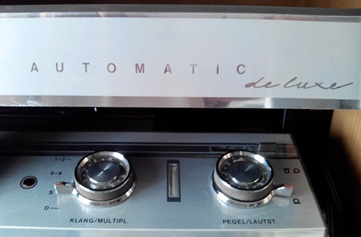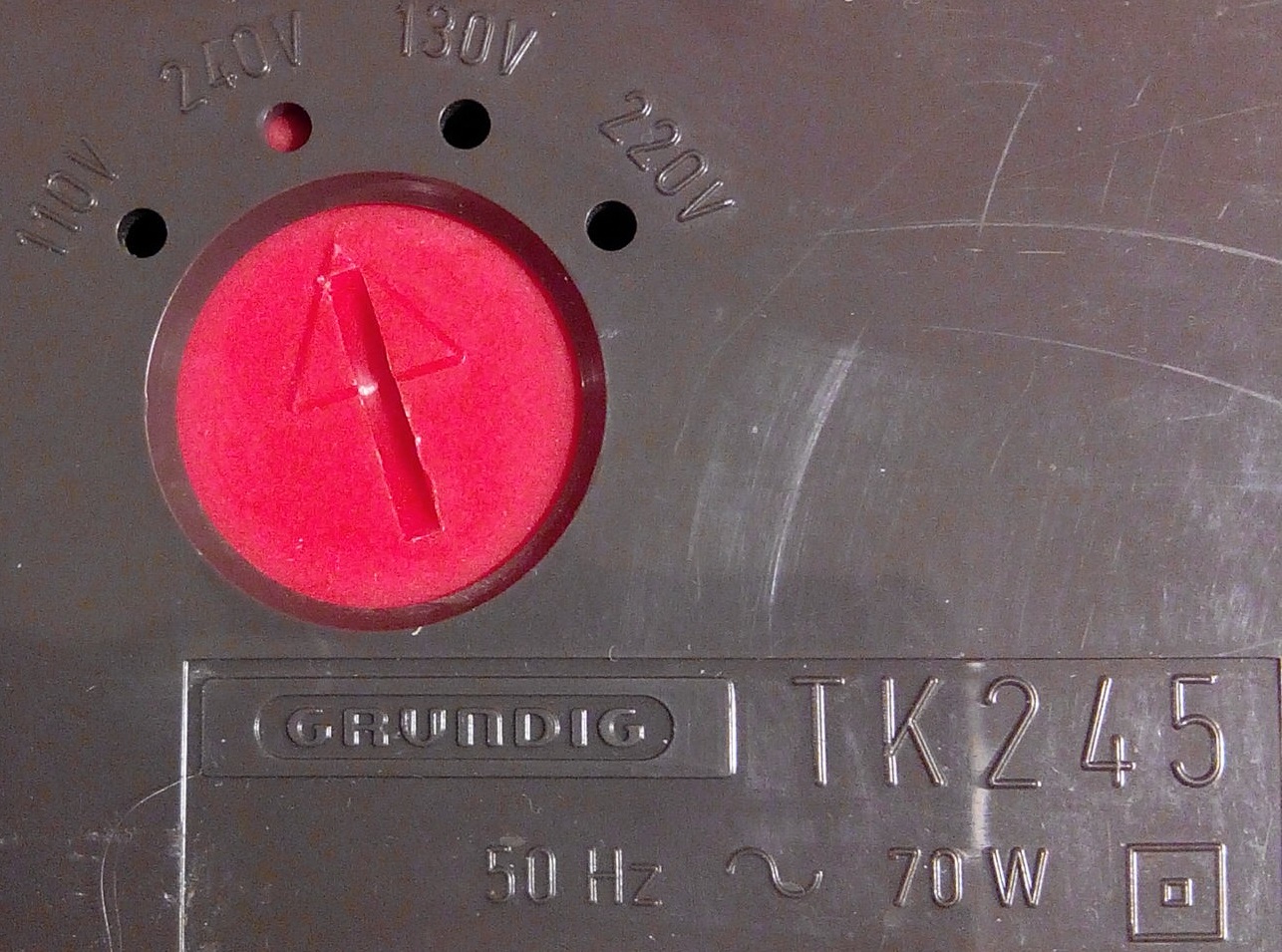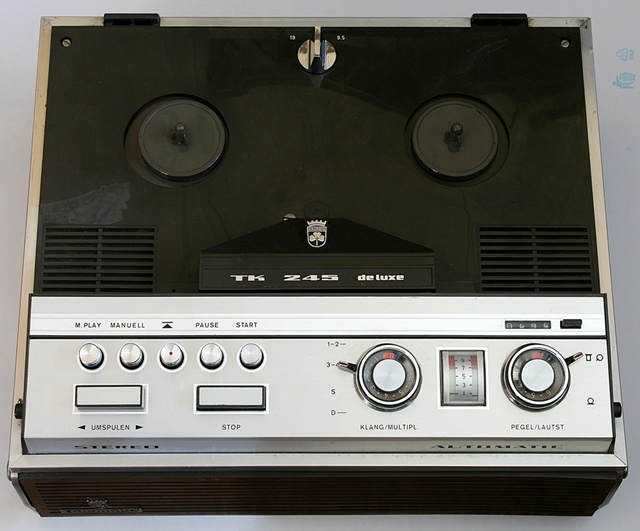Difference between revisions of "Grundig TK 245"
m (Netzspannung seit 1987) |
|||
| (22 intermediate revisions by 5 users not shown) | |||
| Line 1: | Line 1: | ||
__NOTOC__ | __NOTOC__ | ||
| − | == | + | == Data == |
| − | '''''Grundig | + | '''''Grundig Stereo Tape Recorder TK 245 Automatic''''' |
| − | {{ | + | {{navigation}} |
| − | ''' | + | '''General''' |
| − | * | + | * Manufacturer: [[Grundig]] Radiowerke mbH, Fürth |
| − | * | + | * Model: TK 245 AUTOMATIC de Luxe Stereo |
| − | * | + | * Type: Suitcase reel-to-reel tape recorder for horizontal operation with built-in mono amplifier and double loudspeaker |
| − | * | + | * Years of manufacture: 1966 - 1969 |
| − | * | + | * Manufactured in: Fürth |
| − | * | + | * Color: wood grain/walnut, front made of wooden grill |
| − | * | + | * Remote control: no |
| − | * | + | * Power supply: 110 V - 240 V, 50 Hz (60 Hz with conversion kit) |
| − | * | + | * Power consumption: 70 W |
| − | * | + | * Dimensions: 410 x 200 x 340 mm (WxHxD) |
| − | * | + | * Weight: 13,5 Kg |
| + | * Original price: approx. 540 DM without accessories; with original equipment in DEZ 1966 in Hannover 640 DM (65 DM: Microphone GDM-317+ table tripod; 30 DM: 18 cm/ 730 m tape; 11 DM: DIN cable-242) | ||
| − | ''' | + | '''Connections''' |
| − | * | + | * Number of inputs: 4 |
| − | ** | + | ** 2x Micro: 2x 2 - 40 mV / 1,5 MOhm |
| − | ** | + | ** Plate: 2x 90 - 1'800 mV / 1 MOhm |
| − | ** | + | ** Radio (socket = amplifier output): 2x 4 - 80 mV / 44 kOhm |
| − | * | + | * Number of outputs: 3 (of which 1 input=output) |
| − | ** | + | ** Amplifier (socket = input from radio): 2x 1 V/ 22 kOhm |
| − | ** | + | ** Headphone/amplifier monitoring: DIN 2x 1 V/ 22 kOhm. |
| − | ** | + | ** Loudspeaker: 5 Ω for right stereo channel or mono playback (supplement or replacement of the 2 built-in loudspeakers). |
| − | |||
| − | |||
| − | |||
| − | |||
| − | |||
| − | |||
| − | |||
| − | |||
| − | |||
| − | |||
| − | |||
| − | |||
| − | * | + | '''Technical Data''' |
| − | * | + | * Max. Bobbin diameter: 18 cm |
| − | * | + | * Drive: 1 motor, friction wheel drive, fast forward/reverse by belt drive |
| − | * | + | * Heads: 2 heads (erasing head and combined recording/playback head) |
| − | * | + | * Tracks: 4 (quarter track) |
| − | * | + | * Tape speeds: 9.5/ 19 cm/ s |
| − | * | + | * Rewind time: approx. 270 sec. with LS tape 18cm reel |
| − | * | + | * (synchronisation fluctuations): |
| − | ** | + | * Pitch fluctuations: |
| − | ** | + | ** <= +- 0.15 % at 9.5 cm/s. |
| + | ** <= +- 0.12 % at 19 cm/s | ||
| + | * Overall frequency response: | ||
| + | ** 50 - 12,500 Hz at 9.5 cm/s | ||
| + | ** 50 - 16,000 Hz at 19 cm/s | ||
| + | * Dynamic range: | ||
| + | ** >= 45 dB at 9.5 cm/s | ||
| + | ** >= 46 dB at 19 cm/s | ||
| − | |||
| − | |||
| − | |||
| − | |||
| − | |||
| − | + | '''Special Features''' | |
| − | + | * Inertia-less level meter tube (magic tape), from autumn 1967 (radio exhibition) double moving coil meter. | |
| + | * Switchable automatic level control (herewith 1966 for the first time in tape history also for stereo operation) | ||
| + | * Multiplay mix control for trick recording level control | ||
| + | * Without stereo amplifier the tape recorder plays the right channel in stereo operation and can play the left channel with a mono radio (amplifier). This already creates a wide stereo base. | ||
| + | * Depending on the headphone connection type (2 DIN jacks!) only one channel can be heard for trick processing; during playback also both channels, dual mono or stereo. | ||
| + | * Automatic STOP at the end of the tape | ||
| − | + | == Remarks == | |
| + | * Also as [[Grundig TK 247]], then fully transistorized with two built-in 4 watt power amplifiers, without automatic level control. | ||
| + | * The name suffix "de Luxe" was added to all mains tapes until 1968/69, some units before 1966 got "Luxus" or "L" as suffix. From 1969/70 on you see "HIFI" or "HIFI Stereo". | ||
| + | * "de Luxe" was written from the beginning, already in 1966, on the front cover (AUTOMATIC de Luxe), then from autumn 1967 additionally on the sound head cover (photos), under the mains selector switch (as on the [[Grundig TK 247]]), as well as in the updated user manual in many places, while other passages and photos correspond to the first version. Both stereo channels are still controlled together via ONE control, or via automatic. | ||
| − | "de Luxe" | + | * "de Luxe" is not in itself a sufficient indication of vintage, as erroneously claimed in some posts. If you are looking for the more modern double hand instrument, you have to rely on photos or descriptions of the vendor in this regard. Sales forums use the same name for both versions. |
| − | + | * Note: the mains selector was delivered on 220 volts. Since 1987 the mains supply is 230 volts and the selector switch should be changed to 240 volts with a coin (photo) - to protect the unit. | |
| − | |||
| − | |||
| − | == | + | == Other models for comparison == |
| + | '''Models similar to each other until 1969 for horizontal operation (tubes TK 245 + full transistor TK 247):''' | ||
| + | * [[Grundig TK 245]] | ||
| + | * [[Grundig TK 247]] | ||
| + | |||
| + | '''Models of the vertically usable successor series from 1969 in a completely new design, technically of higher quality (e.g. 3 tone heads):''' | ||
| + | * [[Grundig TK 244]] | ||
| + | * [[Grundig TK 246]] | ||
| + | * [[Grundig TK 248]] | ||
| + | |||
| + | |||
| + | == Pictures == | ||
| + | * Pictures: Grundig TK 245 | ||
| + | [[File:245Deckl.jpg|left|mini|1966_Deckel_deLuxe]] | ||
| + | |||
| + | [[File:230-240V.jpg|right|mini|240V_einstellen]] | ||
| + | |||
| + | |||
| + | [[File:TK_245.jpg|center]] | ||
| + | |||
| + | |||
| + | == Reports == | ||
| + | |||
== Links == | == Links == | ||
| − | + | * More about the device at: [[https://bandmaschinen.jimdo.com/tonbandgeräte/grundig-tk-245-deluxe/]] | |
| − | [[ | + | |
| + | |||
| + | [[Category:Tape Machines]] | ||
Latest revision as of 01:33, 20 September 2020
Data
Grundig Stereo Tape Recorder TK 245 Automatic
General
- Manufacturer: Grundig Radiowerke mbH, Fürth
- Model: TK 245 AUTOMATIC de Luxe Stereo
- Type: Suitcase reel-to-reel tape recorder for horizontal operation with built-in mono amplifier and double loudspeaker
- Years of manufacture: 1966 - 1969
- Manufactured in: Fürth
- Color: wood grain/walnut, front made of wooden grill
- Remote control: no
- Power supply: 110 V - 240 V, 50 Hz (60 Hz with conversion kit)
- Power consumption: 70 W
- Dimensions: 410 x 200 x 340 mm (WxHxD)
- Weight: 13,5 Kg
- Original price: approx. 540 DM without accessories; with original equipment in DEZ 1966 in Hannover 640 DM (65 DM: Microphone GDM-317+ table tripod; 30 DM: 18 cm/ 730 m tape; 11 DM: DIN cable-242)
Connections
- Number of inputs: 4
- 2x Micro: 2x 2 - 40 mV / 1,5 MOhm
- Plate: 2x 90 - 1'800 mV / 1 MOhm
- Radio (socket = amplifier output): 2x 4 - 80 mV / 44 kOhm
- Number of outputs: 3 (of which 1 input=output)
- Amplifier (socket = input from radio): 2x 1 V/ 22 kOhm
- Headphone/amplifier monitoring: DIN 2x 1 V/ 22 kOhm.
- Loudspeaker: 5 Ω for right stereo channel or mono playback (supplement or replacement of the 2 built-in loudspeakers).
Technical Data
- Max. Bobbin diameter: 18 cm
- Drive: 1 motor, friction wheel drive, fast forward/reverse by belt drive
- Heads: 2 heads (erasing head and combined recording/playback head)
- Tracks: 4 (quarter track)
- Tape speeds: 9.5/ 19 cm/ s
- Rewind time: approx. 270 sec. with LS tape 18cm reel
- (synchronisation fluctuations):
- Pitch fluctuations:
- <= +- 0.15 % at 9.5 cm/s.
- <= +- 0.12 % at 19 cm/s
- Overall frequency response:
- 50 - 12,500 Hz at 9.5 cm/s
- 50 - 16,000 Hz at 19 cm/s
- Dynamic range:
- >= 45 dB at 9.5 cm/s
- >= 46 dB at 19 cm/s
Special Features
- Inertia-less level meter tube (magic tape), from autumn 1967 (radio exhibition) double moving coil meter.
- Switchable automatic level control (herewith 1966 for the first time in tape history also for stereo operation)
- Multiplay mix control for trick recording level control
- Without stereo amplifier the tape recorder plays the right channel in stereo operation and can play the left channel with a mono radio (amplifier). This already creates a wide stereo base.
- Depending on the headphone connection type (2 DIN jacks!) only one channel can be heard for trick processing; during playback also both channels, dual mono or stereo.
- Automatic STOP at the end of the tape
Remarks
- Also as Grundig TK 247, then fully transistorized with two built-in 4 watt power amplifiers, without automatic level control.
- The name suffix "de Luxe" was added to all mains tapes until 1968/69, some units before 1966 got "Luxus" or "L" as suffix. From 1969/70 on you see "HIFI" or "HIFI Stereo".
- "de Luxe" was written from the beginning, already in 1966, on the front cover (AUTOMATIC de Luxe), then from autumn 1967 additionally on the sound head cover (photos), under the mains selector switch (as on the Grundig TK 247), as well as in the updated user manual in many places, while other passages and photos correspond to the first version. Both stereo channels are still controlled together via ONE control, or via automatic.
- "de Luxe" is not in itself a sufficient indication of vintage, as erroneously claimed in some posts. If you are looking for the more modern double hand instrument, you have to rely on photos or descriptions of the vendor in this regard. Sales forums use the same name for both versions.
- Note: the mains selector was delivered on 220 volts. Since 1987 the mains supply is 230 volts and the selector switch should be changed to 240 volts with a coin (photo) - to protect the unit.
Other models for comparison
Models similar to each other until 1969 for horizontal operation (tubes TK 245 + full transistor TK 247):
Models of the vertically usable successor series from 1969 in a completely new design, technically of higher quality (e.g. 3 tone heads):
Pictures
- Pictures: Grundig TK 245
Reports
Links
- More about the device at: [[1]]


